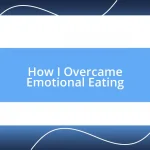Key takeaways:
- Women’s nutritional needs vary through life stages, emphasizing specific nutrients such as iron, calcium, and folate during menstruation, pregnancy, and menopause.
- Common deficiencies among women often include iron, calcium, and vitamin D, which can impact energy, bone health, and overall well-being.
- Effective meal planning and mindfulness can enhance nutritional choices, including meal prep and the “crowding out” strategy to prioritize healthier options.
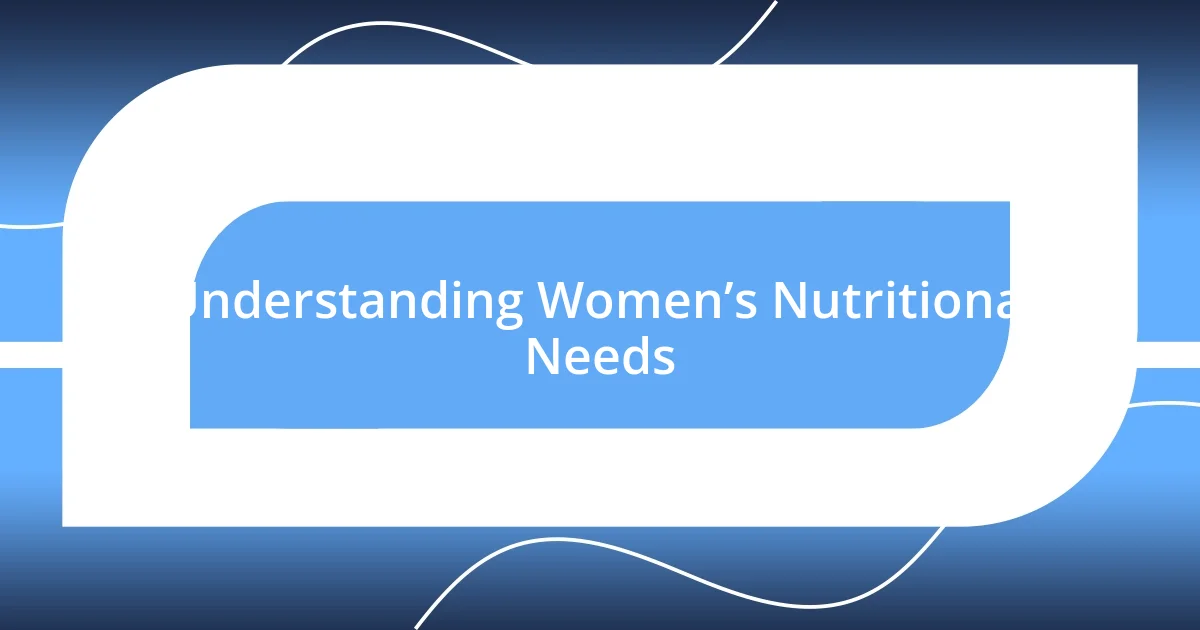
Understanding Women’s Nutritional Needs
Every woman’s body is unique, and so are her nutritional needs. I remember when I first started paying attention to my diet; it was a bit of trial and error. I’d often wonder, “Am I really getting what my body needs?” My experiences taught me that essential nutrients like iron, calcium, and folate became even more crucial as my life stages shifted, from menstruation to pregnancy and menopause.
Women often face specific challenges, such as managing energy levels and dealing with hormonal fluctuations. I recall feeling sluggish during my menstrual cycle and realized my iron intake had dipped. Consuming iron-rich foods like lentils and spinach not only gave me a boost but also made me more aware of how interconnected our nutrient intake is with our overall well-being.
It’s essential to recognize that women’s nutritional needs can vary widely depending on lifestyle and age. Did you know that women generally require more calcium than men due to risks related to bone health? This insight made me re-evaluate my dairy intake and explore alternatives like almonds and fortified plant-based milks. Engaging with nutrition personally has led me to appreciate the role food plays in our happiness and health.
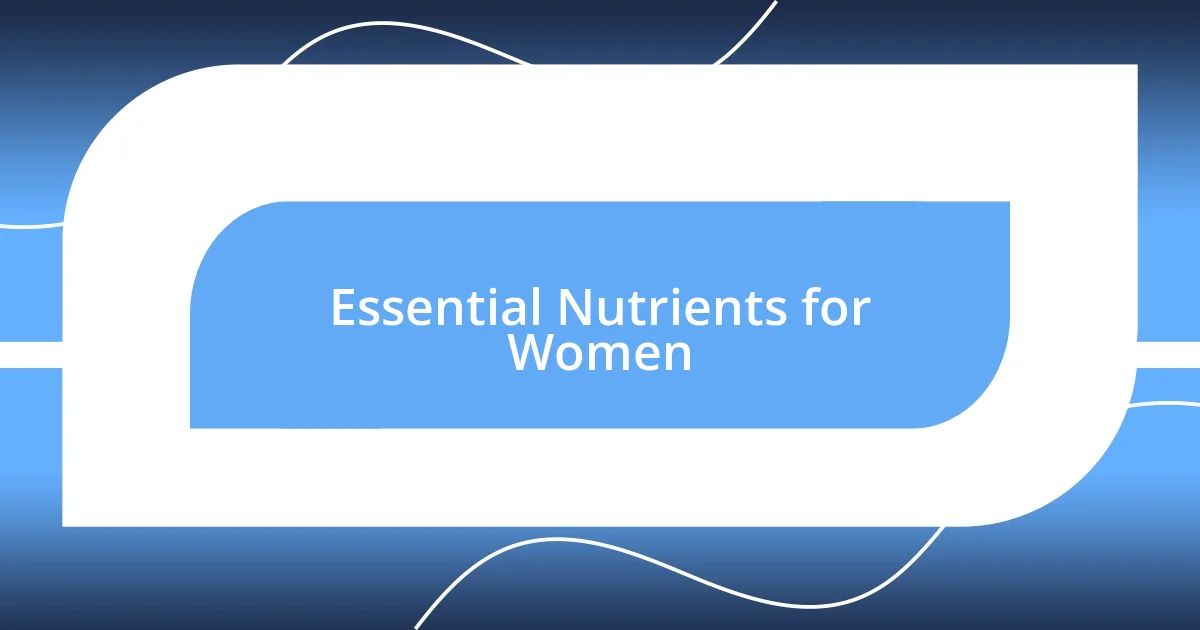
Essential Nutrients for Women
As I’ve delved deeper into women’s nutrition, I’ve noticed that protein is another essential nutrient often overlooked. When I transitioned to a vegetarian diet, I struggled to incorporate enough protein. I found that foods like quinoa, chickpeas, and Greek yogurt not only provided protein but also enhanced my meals. It’s fascinating how focusing on quality sources of protein made me feel more energized and nourished.
Another critical nutrient for women is Omega-3 fatty acids. I used to think these were just for heart health, but I soon learned they play a vital role in reducing inflammation and supporting brain health too. Incorporating flaxseeds and walnuts into my breakfast has been a game-changer. Now, I can’t imagine starting my day without them!
When it comes to vitamins, B vitamins are incredibly important for energy metabolism and mood regulation. I vividly remember a period of stress where my energy plummeted, and adding more leafy greens and whole grains made a significant difference. These nutrients are like little powerhouses, quietly working to keep our bodies functioning optimally.
| Essential Nutrient | Role in Women’s Health |
|---|---|
| Iron | Supports blood health, particularly during menstruation and pregnancy. |
| Calcium | Essential for bone health, especially as women age. |
| Protein | Important for muscle repair and overall energy levels. |
| Omega-3 Fatty Acids | Reduces inflammation and supports brain health. |
| B Vitamins | Important for energy metabolism and mood stabilization. |
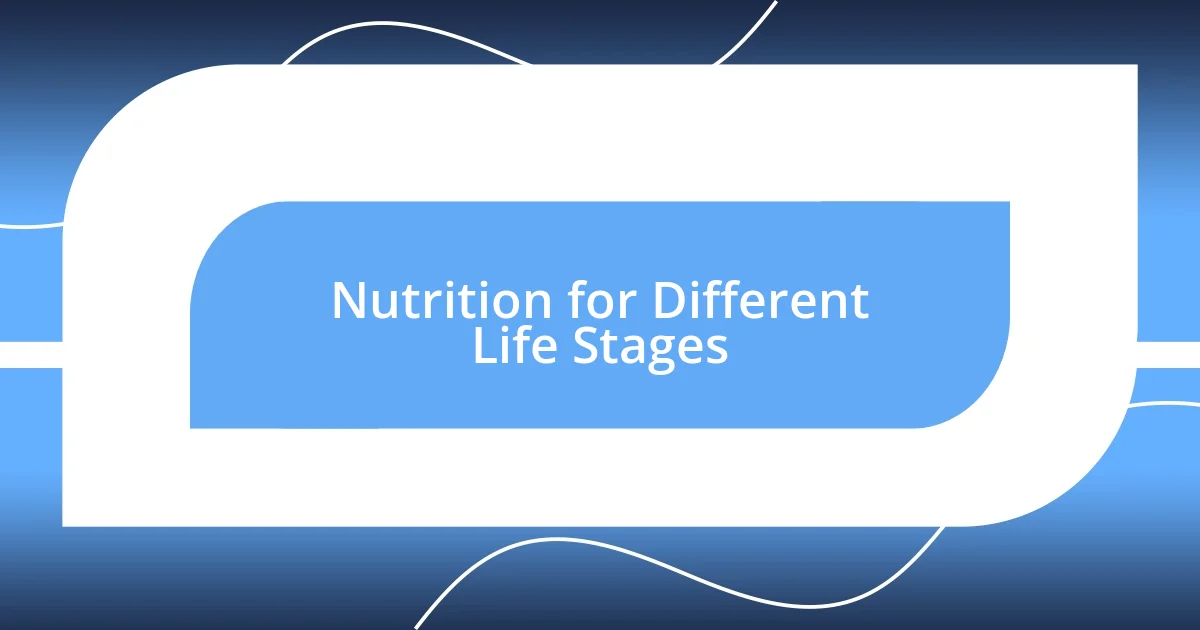
Nutrition for Different Life Stages
Navigating nutrition across different life stages can feel like a journey, and I often reflect on how my nutritional focus has shifted. For instance, during my teenage years, I struggled with acne and learned the importance of hydration and antioxidants. Incorporating fruits like blueberries and vegetables kept my skin clearer, driving home how nutrition directly impacts our health and self-esteem.
As women transition through life, their nutritional needs often evolve. Here’s a practical look at how various stages can change dietary priorities:
- Teenage Years: Increased caloric needs and a focus on calcium-rich foods for bone development—like yogurt and leafy greens.
- Pregnancy: Higher demands for folate to support fetal growth—found in foods like beans and leafy vegetables.
- Postpartum: A need for iron to replenish after blood loss during childbirth; I discovered that red meat and fortified cereals became my staple.
- Menopause: Emphasis on calcium and vitamin D for bone health; I turned to fortified plant milks and small fish like sardines.
- Older Adult: Focus on fiber to maintain digestive health—whole grains and an abundance of fruits and vegetables became paramount.
I have truly learned that each stage provides unique opportunities to nourish our bodies and minds. Personal health has become an adventure, and I’m continually amazed at how the right nutrition can support my well-being during these varied life phases.
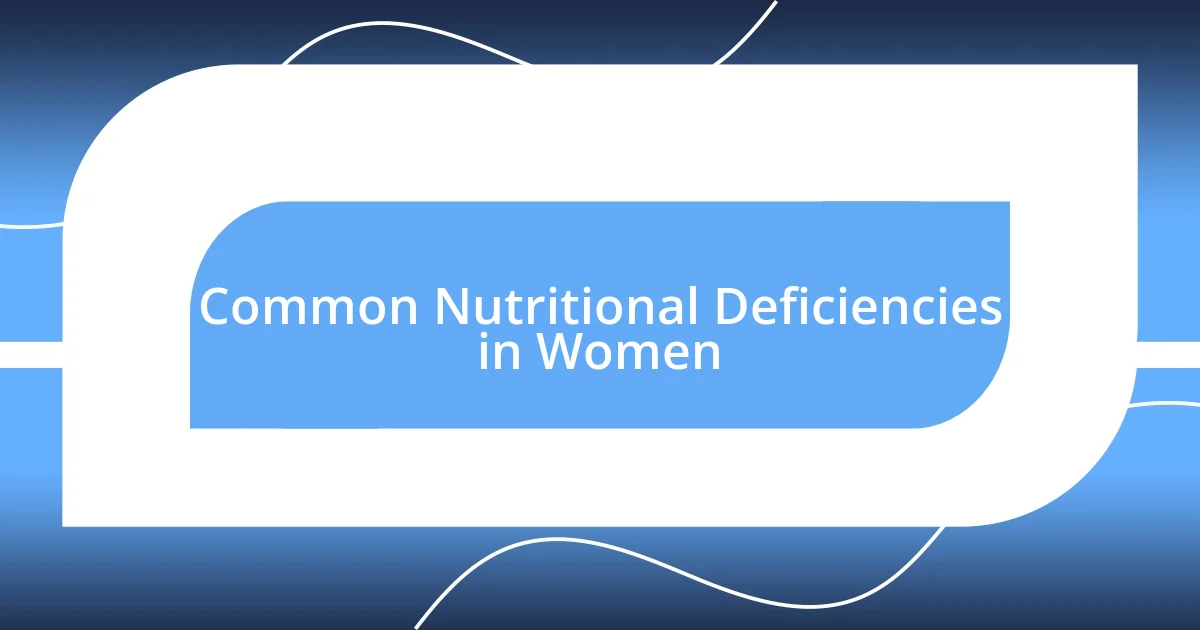
Common Nutritional Deficiencies in Women
Many women face common nutritional deficiencies, and iron is often at the forefront. I remember feeling unusually fatigued and just chalking it up to a busy life, not realizing that my iron levels were likely low. A simple addition of lentils and spinach to my meals made a noticeable difference; it’s incredible how addressing this deficiency can restore energy levels and improve overall well-being.
Calcium deficiency is another concern, especially for women as they age. When I first learned about bone health, I didn’t realize how crucial it was to start early. I started to incorporate more dairy, and even discovered plant-based options, like almond milk and tofu, that helped me meet my calcium needs. The strength I felt in my bones after making those changes was reassuring, and I often wonder how many women overlook this important mineral.
Lastly, vitamin D is a nutrient that can easily go unnoticed. I recall periods, especially during winter months, when my mood would dip—only to realize it might have been linked to low levels of this vitamin. Since incorporating more fortified foods and spending time outdoors, I’ve felt a greater sense of balance. It’s astonishing how small dietary adjustments can lead to significant improvements in health and mood. Are you paying enough attention to your nutrient intake? The impacts can be profound!
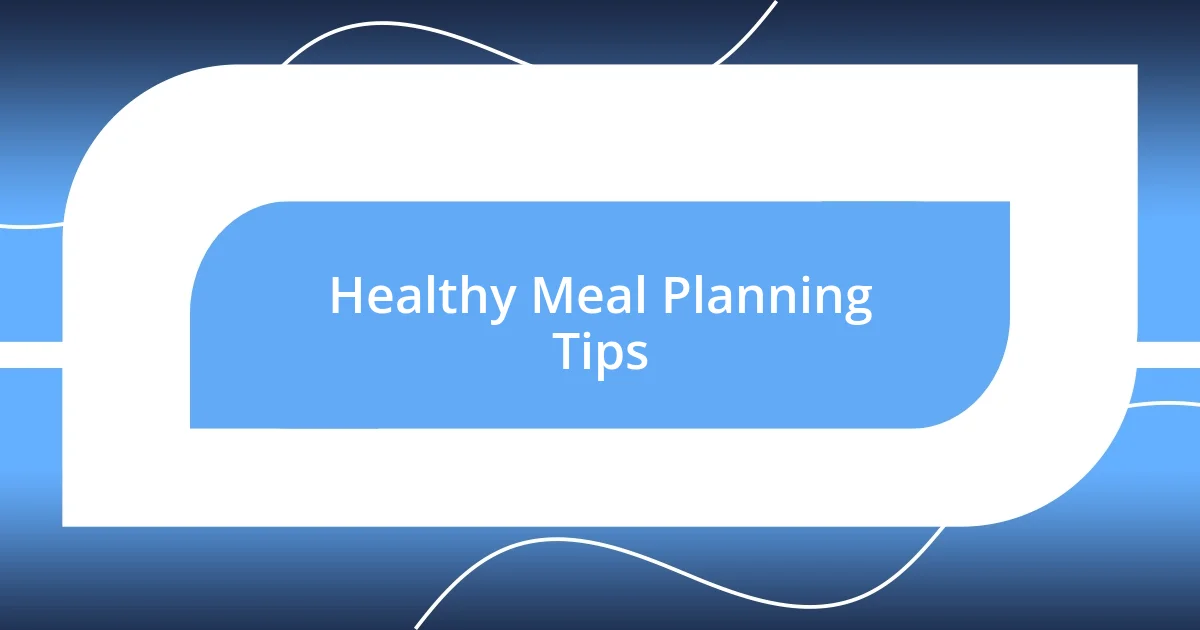
Healthy Meal Planning Tips
When it comes to meal planning, I’ve found that the key is to keep things simple yet nutritious. I like to create a weekly menu that highlights different colors and types of food to ensure a balance of nutrients. For example, I often dedicate Mondays to a hearty vegetable stir-fry packed with bell peppers and broccoli—both great sources of vitamins and minerals. It’s exciting to see how diverse meals can be when I plan them out!
One of my favorite strategies is prepping ingredients ahead of time. I recall a time when my weekdays felt chaotic, and I realized meal prep could save me. I started chopping fruits and vegetables on Sundays, which made throwing together a quick salad or smoothie so much easier during the week. Does anyone else feel that sense of accomplishment when you open the fridge and see perfectly prepped ingredients waiting for you? It definitely transforms the cooking experience from overwhelming to enjoyable.
It’s also important to listen to your body while planning meals. I remember periods when I felt sluggish, prompting me to focus on lighter meals—like quinoa bowls with plenty of greens and proteins. This shift not only made me feel more energized but also enhanced my awareness of how food choices affect my mood and overall health. How often do you check in with how your meals make you feel? It’s a simple yet profound practice that can guide us towards healthier, more satisfying eating habits.
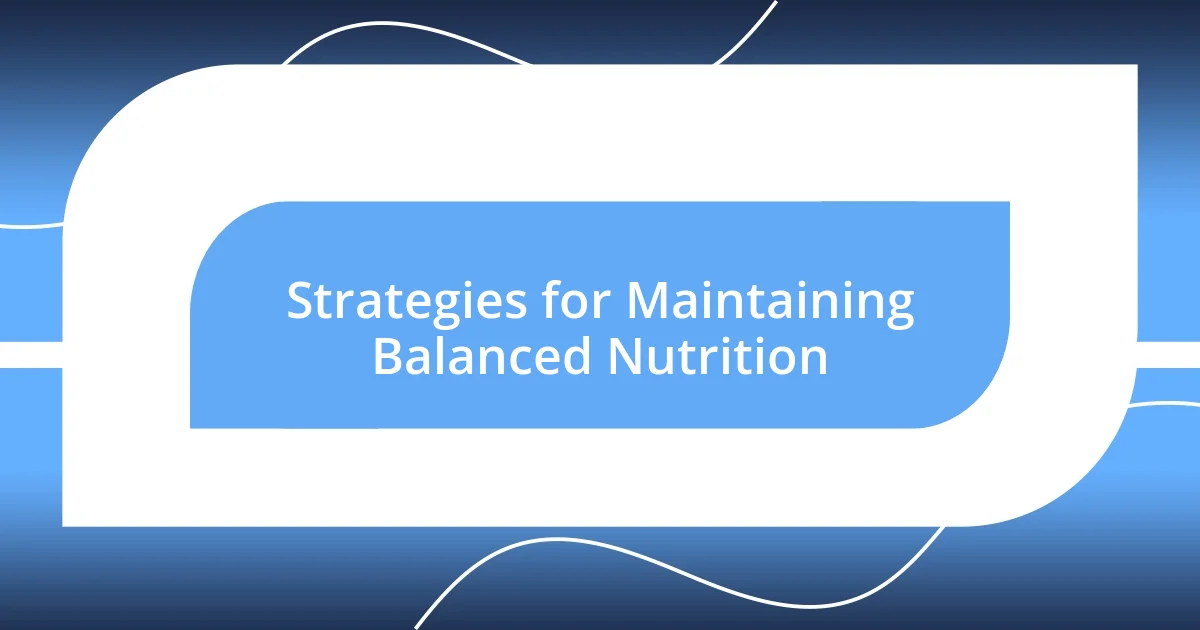
Strategies for Maintaining Balanced Nutrition
Understanding how to maintain balanced nutrition is essential for any woman aiming for optimal health. One of my go-to strategies is keeping a food journal. I started this practice during a particularly busy month and was surprised to see patterns in my eating habits. Tracking what I consumed helped me identify when I was skipping meals or choosing snacks that didn’t provide enough nutrients. Have you ever considered how simple awareness can transform your relationship with food? It’s remarkable what those insights can reveal.
Another effective tactic I’ve embraced is the idea of “crowding out.” Instead of solely focusing on what I should cut out, I’ve found that adding healthier options naturally displaces the less nutritious choices. For example, when I began incorporating more fruits and vegetables into my meals, my cravings for processed snacks diminished. I vividly remember how one week, I challenged myself to incorporate a new type of veggie each day. By Friday, I was happily experimenting with roasted beets—delicious and visually stunning on my plate. How fun is it to discover new foods while nourishing your body?
Lastly, embracing mindfulness when eating has transformed my approach to nutrition. I recall a dinner that turned into a meditative moment—I focused on every bite, appreciating flavors and textures. This practice not only enhanced my enjoyment but also helped me recognize when I was truly satisfied, preventing overeating. Have you paused to savor your meals lately? It’s an experience that can cultivate a deeper connection with your food, ultimately leading to healthier choices and a greater sense of well-being.






